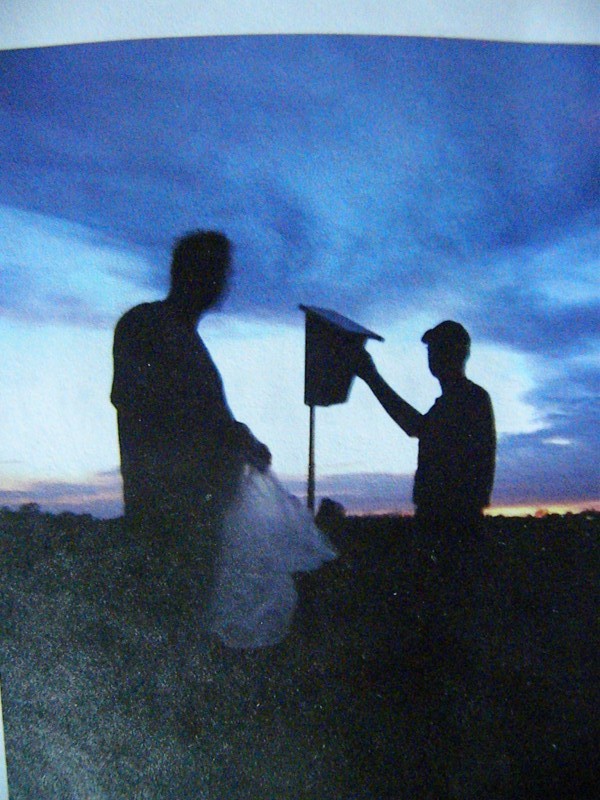Salvaging a Sparrow-Infested Trail:
Not for the Faint of Heart
We are all familiar with this classic movie scene: We see a door swinging open, and there on the doorstep lies a darling baby in a basket. Such an event usually results in big challenges for the main characters in the very next scene! We are about to tell you about an adventure that begins with adoption, not of an infant, but an abandoned bluebird trail.
To set the scene, return with us to Belmont, Michigan, near the Grand River, on the grounds of an operating gravel pit. Brothers-in-law Mark DeHaan and Paul Sherd started their first trail together in 2010, with fifteen boxes installed with permission on land owned by Dykema Excavating. On this trail bordered by the Grand River and a local shopping district, they’ve raised a respectable number of Eastern Bluebird and Tree Swallows, while paying their dues to Passer domesticus (the notorious House Sparrow).
As the two tended their trail in 2010, they couldn’t help noticing that there was a bountiful resource for bluebirds right on their doorstep. The Boulder Creek Golf Course looked like unclaimed prime bluebird real estate. One afternoon after monitoring their gravel company trail, they cut across the course just to get a closer look at this tempting property. They were surprised to discover there were some boxes already installed on the course, but the three they found appeared to be infested with sparrows. Now their desire to get a trail going on the golf course was really piqued.
This past spring, Paul put thought into action and approached the course’s management, to ask if anyone was managing the trail. When the groundskeeper heard there were monitors interested in this trail, he was all ears. He knew something had gone horribly wrong, because all the bluebirds and swallows that he used to see on the grounds had disappeared! Overjoyed, he gave our men the nod.
The Door Opens
Mark and Paul didn’t waste any time once they had permission to enter the golf course and tend to the boxes. They took a walk through and counted nineteen, and soon learned there wasn’t much that was cute about their foundling. As a matter of fact, it had been a “basket case” of neglect for a small number of years. Every box without exception was stuffed with old sparrow nests that had been used several times, and many contained a fresh new batch of sparrow eggs. If you’ve ever pried such a nest from a box, you’ll know it comes out in a cloud of dust, a shower of bird dander, and several exclamations such as “Phew!” and “Yuck!” not to mention one or two words we can’t print. In hindsight, this “lost” trail may have been the source of House Sparrows that attacked and destroyed several native birds on the Gravel Pit Trail last summer.
A New Challenge
Well, this outlook was a bit daunting! How could they rid their heavily infested trail of so many alien flying pests? Early on, Paul confided to me that his first dark thought was that it could take two years to remove them all. But on that first walk through, the men actually caught birds with bare hands as they opened boxes for the first time. Encouraged now, they were in agreement; if they came back after dark, they might be able to round up a good number of the inhabitants in one night visit.
Night Raids
You may have heard of the “Night Sneak” method of sparrow trapping: I saw it in action this summer. Here is how it was done at Boulder Creek the night I tagged along on the trail. Mark carried a bag as large as a garbage bag, plastic, and transparent. It is large enough to fit over the entire box to allow the box to open inside the bag. This was teamwork: Paul sneaked up to the box to put his hand over the entrance, and Mark would “bag” the box. The both held the bag close to the box so there would be no escape routes. When they opened the box the sparrow would choose to fly into the bag, or hide inside the box. Either way, they could get hold of it with the bag still tightly held over the box. The birds were humanly dispatched without delay.
They made several raids, a week or so apart. Each successive trip in the dark caught fewer sparrows, and each time, they found more boxes that had no sparrow nests in them. They asked me along on their latest raid once recent summer night, while I gathered material for this story. We visited only three boxes that Paul had scouted out as the remaining sparrow nests, removing the birds with their eggs and nests yet again. Total score: 55 Houses Sparrows removed.
A Glimmer of Hope
Shortly after Mark and Paul’s second night raid, a bluebird pair moved into one of their cleared boxes and subsequently raised their first brood on the “renewal in progress” trail. As of this writing, the female is beginning to incubate their second clutch of five beautiful eggs!
Peggy Falk is Newsletter Director for the Michigan Bluebird Society and a member of NABS. This article originally appeared in the Summer 2011 issue of The Bluebird Flyer, the newsletter of the Michigan Bluebird Society.

